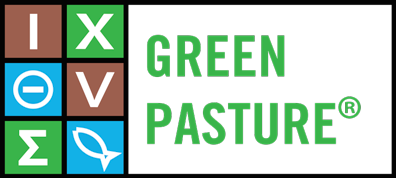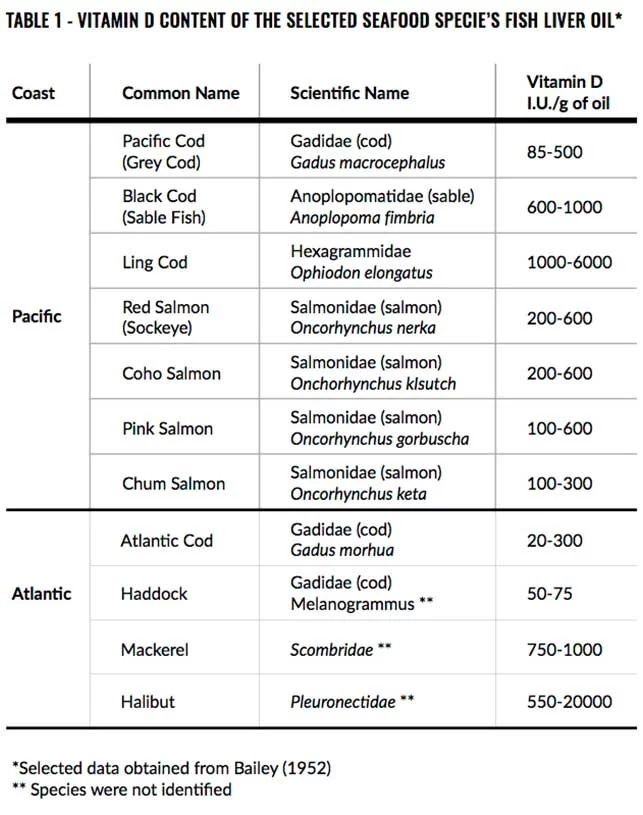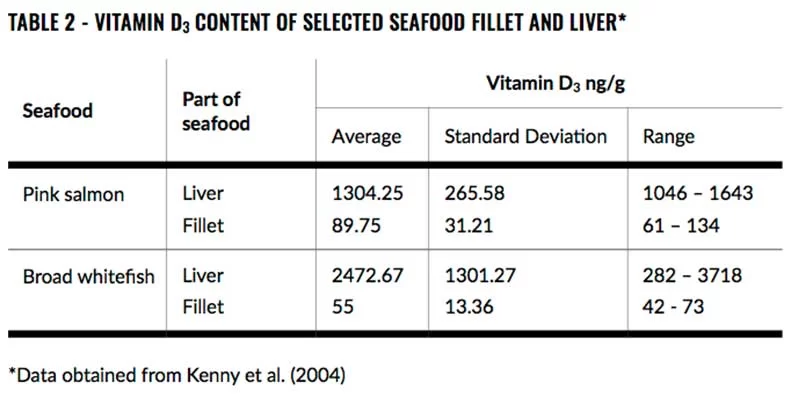Published by Dr. Subramaniam Sathivel on December 7, 2016
Table of Contents
- All Natural Vitamins, No Synthetics Added!
- Natural Vitamin Content Varies – Its Only Natural
- The Importance of Vitamin D
- Fish Oils and Vitamin D Content
- Variations of Natural Vitamin D in Fish Oils
- Vitamin Content Should be Reported as a Range
All Natural Vitamins, No Synthetics Added!
Our labels state “Fermented Cod Liver Oil contains naturally occurring vitamins A and D” and notes that “the amounts of these nutrients will vary.” Although the absence of a firm number of IUs in the Supplement Facts may disappoint some consumers, our statement reflects the reality that the fat-soluble vitamin content of fish oils is naturally variable when no synthetic vitamins are added. Scientists recognize that a number of factors shape the vitamin and nutrient profile, including geography, season, and fish species.
Natural Vitamin Content Varies – Its Only Natural
We consulted with Dr. Subramaniam Sathivel on the subject of the vitamin D content of fish oils and cod liver oils. Dr. Sathivel is a professor of Food Engineering at Louisiana State University and formerly a Seafood Processing and Engineering professor at the University of Alaska. Dr. Sathivel’s comments show that, far from being a simple topic, scientists are still trying to figure out how various forms of vitamin D make their way from plankton to fish, and also explain why scientists typically report fat-soluble vitamin values as ranges rather than averages.
Fundamentally, what is interesting to note is that Dr. Sathivel’s research mirrors our own experience and reaffirms the accuracy of the claims on our label.
Below is a summary of Dr. Sathivel’s research and conclusions on the subject.
Fat-Soluble Vitamins, Especially Vitamin D Variation in Marine Fish
The Importance of Vitamin D
Vitamin D is a fat-soluble nutrient and plays major roles in bone formation (Holick, 2007). It is significant in brain, heart, muscles, immune system, and skin function. Researchers have also reported that vitamin D may be beneficial in reducing the risk of diseases such as cancer (Garland et al., 2009), including skin cancer (Armstrong and Kricker, 2001).
Humans obtain vitamin D through sunlight, diet, and vitamin D supplements. There are two forms of vitamin D that are biologically available to humans: (1) D2 (ergocalciferol) and (2) vitamin D3 (cholecalciferol). Plants produce vitamin D2 in only limited amounts. Therefore, humans acquire only limited vitamin D2 from fruits and vegetables. The primary source of vitamin D2 is dietary supplements.
Vitamin D3 is known as the sunshine vitamin. It is synthesized in humans when skin is exposed to Ultraviolet-B light (UVB) at wavelengths in the range of 290 to 315 nm (MacLaughlin and Anderson, 1982). Vitamin D3 plays a major role in bone health in children and adults. It has also been reported that vitamin D3 reduces the risk of cancer and cardiovascular diseases (Wagner and Greer, 2008). The main function of vitamin D3 is to regulate blood calcium and phosphorus levels. It assists the absorption of calcium and phosphorus from food in the intestines and the reabsorption of calcium in the kidneys. This process allows regulation of blood calcium and phosphorus levels and normal mineralization of bone (Norman, 1990; Norman, 2006).
The lack of sun exposure may lead to vitamin D3 deficiency in both children and adults. Vitamin D recommended dietary dosage for adults is 5–20 g/day (200–800 IU), which may prevent osteomalacia in adults who are not exposed to adequate sunlight. Vitamin D3 can be obtained from diet or supplements (Lu et al., 2007). Vitamin D3 occurs naturally in high amounts in fatty fish such as salmon, herring, and mackerel, and in fish oils. Food manufacturers have also developed vitamin-fortified foods such as milk, yogurt, cheese, margarine, and calcium-fortified orange juice.
Fish Oils and Vitamin D Content
Fish oils are extracted from whole fish and fish byproducts including heads, liver, and viscera of fish. Fatty fish and fish liver are good sources of vitamin D, a fat-soluble vitamin (Mattila et al., 1995; Sunita Rao and Raghuramulu, 1995; Jacobs and Wood, 2004; Lu et al., 2007). Therefore, there may be the expectation that fish oil contains a consistently high amount of vitamin D. However, the amount of stored vitamin D in fat molecules in fish tissues may vary with a number of factors, including species, age, and size of fish. Vitamin D content in fish oil may vary with the source within the fish—flesh, liver, or viscera. Geographic location and season may also play roles in the variation of vitamin D content in fish oils.
Lu et al. (2007) have reported that vitamins contained in fish oil vary with fish species. For example, wild-caught salmon fish flesh (fatty fish) contains 988±524 IU vitamin D3/100g, while white fish flesh (lean fish) such as cod contains 104±24 IU vitamin D3/100g.


Variations of Natural Vitamin D in Fish Oils
Bailey (1952) has reported that fish liver oil contains higher amounts of vitamin D than fish flesh regardless of the fish species. For example, sockeye salmon liver oil has higher vitamin D (200- 600 IU vitamin D/g) content than its flesh (60 IU vitamin D/g). Cod oil is extracted from cod liver, which contains between 85-500 IU vitamin D/g of oil (Bailey, 1952). Stancher and Zonta (1983) have reported that cod liver oil contains 150 IU vitamin D3/g of oil. Vitamin D2 is produced by plants; marine fish tissue may contain both vitamins D2 and D3. Both are delivered to marine fish when they consume phytoplankton and zooplankton, which contain them (Sunita Rao and Raghuramulu, 1995). This may be a reason why wild-caught marine fish have higher vitamin D2 content than farm-raised fish (Trang et al., 1998). Kenny et al. (2004) have reported that there is no clear evidence phytoplankton and zooplankton are vitamin D sources for marine fish because, in their research, they did not find measurable vitamin D in phytoplankton and zooplankton. They have found that phytoplankton and zooplankton contain pro-vitamin D3, 7-dehydrocholesterol (7-DHC), which is converted to pre-vitamin D when it is consumed (Holick, 2003). Pre-vitamin D is metabolized to produce the biologically active form vitamin D3 (Holick, 2003). Kenny et al. (2004) have indicated that stored vitamin D in fish may not come directly from their diet. In addition, the research group mentioned that there may be different species within phytoplankton and zooplankton and their ability to produce pro-vitamin D or vitamin D may vary. Geographic differences may also influence the pro-vitamin D or vitamin D production in phytoplankton and zooplankton due to UVB light penetration in the water (Kenny et al., 2004).
The previously mentioned factors may be reasons, in general, scientists have reported fat-soluble vitamin values as ranges instead of average values because the standard deviation for an average value of a fat-soluble vitamin is expected to be large. If the standard deviation of a value is large, then the value of individual samples would be expected to vary greatly, and a range of values may be more appropriate than an average value. For example, in 2004, the Kenny research group reported average vitamin D3 content (ng/g) of pink salmon fillet and liver of 89.75 + 31.21 and 1303.25 + 265.58, respectively. The standard deviations in their study for vitamin D content in the fillet and liver are large. This may be a reason the authors have also provided the range of vitamin D content (ng/g) in fillets and liver, which are 61-134 and 1046-1643 (ng/g), respectively.
Vitamin Content Should be Reported as a Range
Fat-soluble vitamins K, D, A, and E may be contained in fish oils. The vitamin content may vary with species, their ages, sizes, and parts of the fish. Geography and seasons may also influence their contents, especially vitamin D in fish oils. In my opinion, unless fish oil has been fortified with vitamin D, we should report the vitamin D content of fish oil as a range instead of an average value. If not, we should provide the standard deviation from the average value. It would be expected that a typical range of values would be more meaningful to a consumer without a background in statistics than an average value with standard deviation.
About the Author
Dr. Sathivel is the Professor of Food Engineer at the School Nutrition and Food Sciences and the Department of Biological and Agricultural Engineering, Louisiana State University Agricultural Center (LSUAC). Before joined LSUAC, Dr. Sathivel worked five years as an Assistant Professor of Seafood Processing and Engineering at the Fishery Industry Technology Center (FITC), University of Alaska Fairbanks, Alaska. He is responsible for the food process engineering laboratory at the LSUAC, where his projects include design and development of an adsorption technology to purify fish oils and fish protein, value added products, edible films and edible coatings. Dr. Sathivel has published 60 refereed articles, two popular articles, five book chapters, and six proceedings. Dr. Sathivel has an equally respectable record of published abstracts and professional presentations, many of which were invited talks at international scientific meetings and conferences.
References
Armstrong, B. K., & Kricker, A. (2001). The epidemiology of UV induced skin cancer. Journal of photochemistry and photobiology B: Biology, 63(1-3), 8-18.
Bailey, B. E. (1952). Marine oils with particular reference to those of Canada. Fish. Res. Bd. Can., Bull., 89, 1-413.
Garland, C. F., Gorham, E. D., Mohr, S. B., & Garland, F. C. (2009). Vitamin D for cancer prevention: global perspective. Annals of epidemiology, 19(7), 468-483.
Holick, M. F. (2007). Vitamin D deficiency. New England Journal of Medicine, 357(3), 266-281.
Holick, M. F. (2003). Vitamin D: A millenium perspective. Journal of cellular biochemistry, 88(2), 296-307.
Jacobs, P. and L. Wood. 2004. Macronutrients: vitamin D. Dis Mon. 50:59–68.
Kenny, D. E., O’Hara, T. M., Chen, T. C., Lu, Z., Tian, X., & Holick, M. F. (2004). Vitamin D content in Alaskan Arctic zooplankton, fishes, and marine mammals. Zoo Biology: Published in affiliation with the American Zoo and Aquarium Association, 23(1), 33-43.
Kricker, A., Armstrong, B. K., & English, D. R. (1994). Sun exposure and non-melanocytic skin cancer. Cancer Causes & Control, 5(4), 367-392.
Lu, Z., Chen, T. C., Zhang, A., Persons, K. S., Kohn, N., Berkowitz, R., … & Holick, M. F. (2007). An evaluation of the vitamin D3 content in fish: Is the vitamin D content adequate to satisfy the dietary requirement for vitamin D?. The Journal of steroid biochemistry and molecular biology, 103(3-5), 642-644.
MacLaughlin, J. A., Anderson, R. R., & Holick, M. F. (1982). Spectral character of sunlight modulates photosynthesis of previtamin D3 and its photoisomers in human skin. Science, 216(4549), 1001-1003.
Mattila, P., Piironen, V., Uusi-Rauva, E., & Koivistoinen, P. (1995). Cholecalciferol and 25-hydroxycholecalciferol contents in fish and fish products. Journal of food composition and analysis, 8(3), 232-243.
Moghadasian, M. H. (2008). Advances in dietary enrichment with n-3 fatty acids. Critical Reviews in Food Science and Nutrition, 48(5), 402-410.
Norman, A. W. (1990). Intestinal calcium absorption: a vitamin D-hormone-mediated adaptive response. The American Journal of Clinical Nutrition, 51(2), 290-300.
Norman, A. W. (2006). Vitamin D receptor: new assignments for an already busy receptor. Endocrinology, 147(12), 5542-5548.
Stancher, B., & Zonta, F. (1983). High-performance liquid chromatography of fat-soluble vitamins: simultaneous quantitative analysis of vitamins D2, D3, and E. Study of percentage recoveries of vitamins from cod liver oil. Journal of Chromatography A, 256, 93-100.
Rao, D. S., & Raghuramulu, N. (1995). Vitamin D and its related parameters in fresh-water wild fishes. Comparative Biochemistry and Physiology Part A: Physiology, 111(2), 191-198.
Trang, H. M., Cole, D. E., Rubin, L. A., Pierratos, A., Siu, S., & Vieth, R. (1998). Evidence that vitamin D3 increases serum 25-hydroxyvitamin D more efficiently than does vitamin D2. The American journal of clinical nutrition, 68(4), 854-858.
Wagner, C. L., & Greer, F. R. (2008). Prevention of rickets and vitamin D deficiency in infants, children, and adolescents. Pediatrics, 122(5), 1142-1152.






